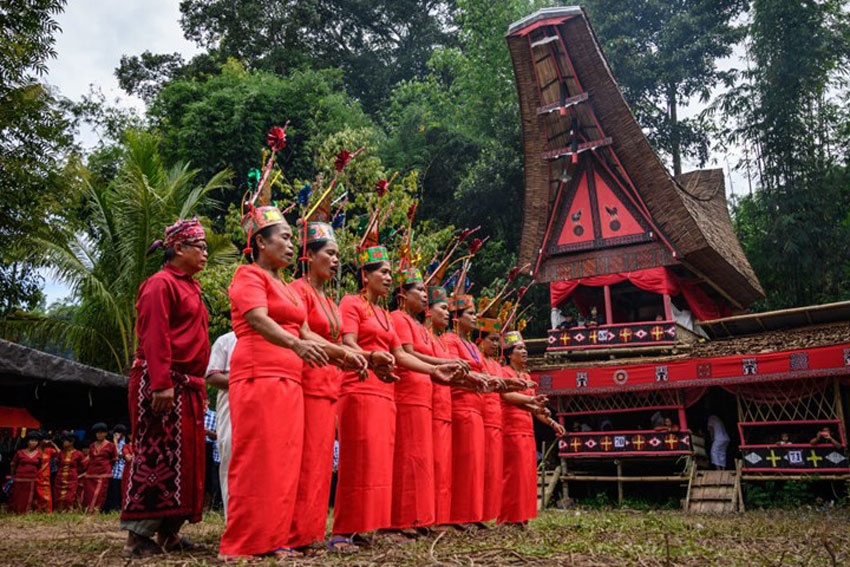To outsiders, the idea of keeping a dead man’s body on show at home feels quite alien. Yet for more than a million people from this part of the world – the Toraja region of Sulawesi in eastern Indonesia – it’s a tradition dating back centuries. Here, animist beliefs blur the line between this world and the next, making the dead very much present in the world of the living.
Toraja
After someone dies, it may be months, sometimes years, before a funeral takes place. In the meantime, the families keep their bodies in the house and care for them as if they were sick. They are brought food, drink and cigarettes twice a day. They are washed and have their clothes changed regularly. The dead even have a bowl in the corner of the room as their “toilet”. Furthermore, the deceased are never left on their own and the lights are always left on for them when it gets dark. The families worry that if they don’t take care of the corpses properly, the spirits of their departed loved ones will give them trouble.
Traditionally, special leaves and herbs were rubbed on the body to preserve it. But nowadays, a preserving chemical, formalin, is injected instead, which leaves a powerful chemical smell in the room.
“Although we’re all Christians, relatives often visit him or call on the phone to see how Dad’s doing, because we believe that he can hear us and is still around,” Namak Lisa says of her father who, actually died 12 years ago, feeling an emotional attachment with him.
Contrary to what we are used to, there is no sign of fear of the dead among the Torajans.
My own father passed away some years ago, and he was buried almost immediately and I have never been able to get over that grief. To the Torajans, keeping the dead under the same roof helps them to slowly come to reality about their death.
During their lives, Torajans work hard to accumulate wealth. But rather than striving for a luxurious life, they’re saving up for a glorious departure. Cirinda will lie here until his family is ready to say goodbye – both emotionally and financially. His body will finally leave the family home during an unimaginably lavish funeral, after a grand procession around the village.
According to Torajan belief, funerals are where the soul finally leaves this Earth and starts its long and hard journey into Pooya – the final stage of the afterlife, where the soul gets reincarnated. Buffaloes are believed to be the carriers of the soul into the afterlife and that’s why families sacrifice as many of them as they can, to help make the journey easier for the deceased.
Torajans spend most of their lives saving up for these rituals. Once the families have saved up enough, they invite all friends and relatives from all over the world. The wealthier the deceased when alive, the larger and more elaborate these ceremonies.
After the funeral, it’s finally time to inter the dead. Torajans are rarely buried in the ground. Instead, they are either interred in family tombs or placed inside or outside caves – as it’s a mountainous region, there are many of them. These caves are yet another place where the afterlife seemingly connects with this one. Sometimes winding for kilometres, they hold innumerable coffins and corpses, and even loose skulls and bones. Friends and family bring “necessities” for their dead relatives – often money and cigarettes.
In a tradition pre-dating photography, the images of dead noble men and women are carefully carved out of wood. Known astau tau , these sculptures wear the clothes, jewelry and even the hair of the deceased – silent sentinels looking out over this world from another plane. On average they cost 3.7m ushs to make.
And the ceremony itself is not a final good bye. The physical relationship between dead and the living continues long after, through a ritual called ma’nene , or the “cleansing of the corpses”. Every couple of years, families take the coffins of long-departed relatives out of their graves and open them up, for a big reunion with the dead. At ma’nene ceremonies, friends and family offer food and cigarettes to the dead and lovingly groom and clean them. Then they pose with them for new family portraits.
Torajan professor of sociology Andy Tandi Lolo describes it as a way of maintaining “social interaction between those who are alive and those who are dead”.
In many villages, they change the outfit for a new one and even take the corpse for a walk around the village. But these practices are slowly disappearing, as over time more than 80% of Torajans have turned away from the old animist religion,Aluk to dolo , and have become Christians. Little by little, the old ways are changing, as a result.
However, Christianity and Aluk to dolo have always coexisted, for as long as Christianity has been in this region.
Andy Tandi Lolo says that when Dutch missionaries first arrived, less than a century ago, they tried to forbid animist religions altogether. By the 1950s, though, they had realised that if they wanted Torajans to accept the new faith, they would have to show flexibility, and allow them to continue their rituals.
In Uganda, and the rest of the world, these practices may seem bizarre. But perhaps the principles behind them are not so very different from those found in other cultures. Remembering the dead is something many of us try to do. The Torajans just take a very different dimension.
Do you have a story in your community or an opinion to share with us: Email us at editorial@watchdoguganda.com













